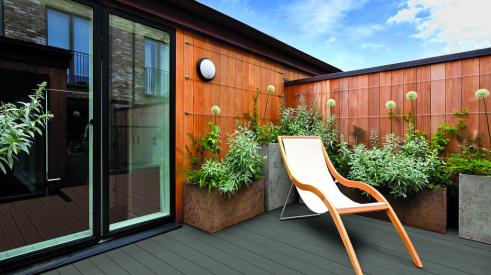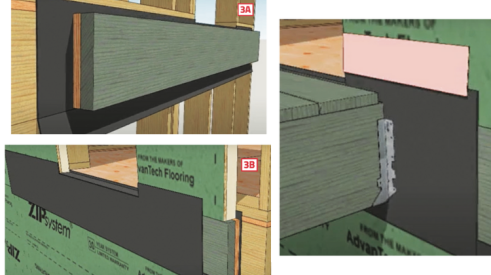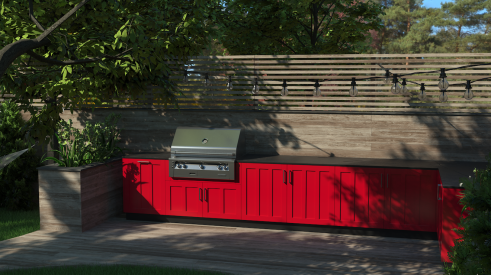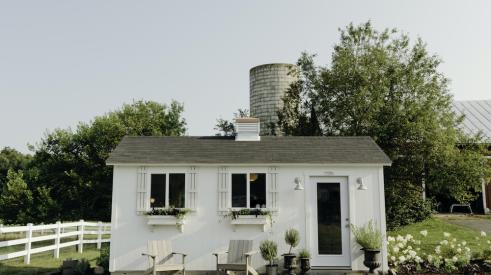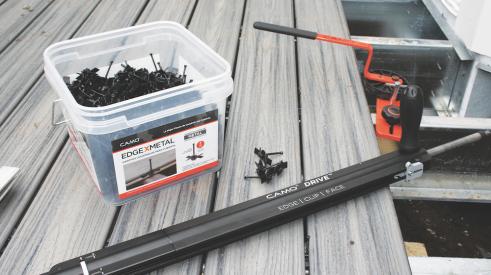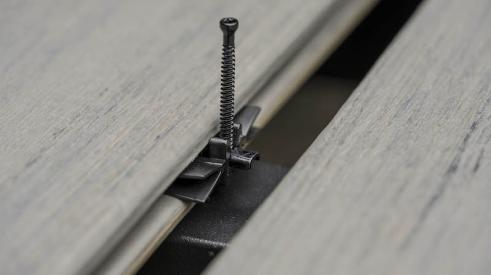 |
| This wood deck is integrated with the landscape, taking advantage of shady trees and a view of a well-manicured lawn. Photo courtesy of Southern Pine Council |
Across the country, clients are requesting maintenance-free, environmentally conscious decking products, and they're asking for ways to improve the outdoors and the time they spend there. Manufacturers, builders and remodelers alike are stepping up to the plate by expanding their offerings. Here are five of the biggest trends in outdoor living today.1 Composite vs. Wood Decks
The almost mythical lure of the maintenance-free deck makes it a hot topic. "Although customers request maintenance-free most often, it's not necessarily the right product for them," says Patrick Henry Nicholson, C.R., chief executive officer of Deckmasters, a deck-building franchise based in Pittsburgh.
"If the homeowners are going to live in the house five years or less, I recommend wood," says Nicholson. "If they'll be there 10 to 15 years, I'd say invest more and go with composite."
But Nicholson cautions fellow builders and remodelers to do their homework. "Very few composites are actually good. Check up on all of them; don't just buy the cheapest," he warns. "Some do not perform — they deteriorate, swell up, easily mark, change color or stain — and it makes for an unhappy customer."
Nicholson says plastics are good, although builders and remodelers must plan for their expansion and contraction in construction. He's been happy with vinyl.
On the other hand, Dave Lombardo, president of American Deck, says choosing decking materials depends on the location: "Our Mid-Atlantic region looks to alternatives like vinyl, aluminum and composites, while the West Coast still likes wood. The Pacific Northwest is a popular, well-developed alternative market, but they still hold on to that rugged, natural look. For the Southeast, it's wood and economical pressure-treated products. In the middle of country, budgets aren't as high, so 'value' is the key word. And the country as a whole is 80 percent pressure-treated wood and wood in general."
In southeastern Virginia, for example, Casa Decks has built more composite decks over wood — in fact, they've been 100 percent composite for the last five years, says President George Drummond — and they are moving toward a higher-end, more expensive composite. "We have a mold and mildew issue here," Drummond says. "The more expensive types have a better encapsulation process and are easier to keep clean."
 |
| This multilevel composite deck creates distinct outdoor rooms — each with different decking patterns — as well as a full-service kitchen and fire-pit. Photo courtesy of Fiberon |
Over the last 18 months to two years, Drummond says he's been using a vinyl product by Procell Decking Systems, which he claims reflects heat instead of absorbing it, an important feature for his region. Procell's limited shades, however, have become a concern. "All of the colors are light pastels," he says. "Homeowners are looking for more color options. They want to match the deck color to their brick — they don't even care about the product."
"Composites, vinyls, etc. continue to grow in popularity ... mostly for the promise of no maintenance," says Steve Cory, author of Sunset's "Complete Deck Book." "I have a feeling that in 10 years or so, there will be a backlash, and people will want to return to natural wood."
The wood market is ready and flush with new preservatives — especially organics, which are sure to appeal to green-conscious customers. All this makes for the most important trend, says Richard Kleiner, director of treated markets for the Southern Forest Products Association, "and more choices for the consumer when selecting decking products," he says.
"Consumers and builders can expect to see a new generation of organic preservatives used in above-ground Southern Pine decking. These products contain no metals," Kleiner says. "For consumers and designers who are concerned about toxins and heavy metals, these products take those issues off the table."
One example, says Kleiner, is Arch Treatment Technologies' Wolmanized L3Outdoor Wood. This product is completely organic, with no arsenate or metals. According to the company, the waterborne preservative consists of fungicides tebuconazole and propiconazole, as well as imidacloprid, which is an insecticide.
Viance, too, is looking to regain market share from composite manufacturers with its new product Ecolife, a wood stabilizer with an organic preservative. Dave Fowlie, vice president of business development, says Ecolife "makes wood perform better, improves weathering performance, as well as has environmental attributes."
 |
| Positioned just steps from the house and illuminated by tiki torches, a bubbling hot tub promises a relaxing evening. Photo courtesy of Southern Pine Council |
And Osmose has come out with an alternative to alkaline copper quaternary (ACQ) called MicroPro, which is micronized copper quaternary, or MCQ. "There's always concern about corrosion from ACQ," says Kleiner. "MCQ is less corrosive and similar to CCA (chromated copper arsenate) treated wood and untreated wood."2 Multilevel Decks
Multilevel concepts are very popular. They create two or more separate spaces, sometimes reinforced by distinctly different decking surface patterns. This concept helps promote a two-decks-in-one feeling: one for entertaining and the other for a more private setting for a secluded spa at ground level. Or locate one deck in the shade, such as beneath a large tree, and the other in a spot that will be bathed in sunshine.
One way to get the split-level look, Nicholson says, is to break up a staircase with landings instead of making it one long run.
Drummond says he is creating smaller decks that step down into stamped concrete or a patio or serve as an extension to a pool deck. Part of the reason for this configuration, he says, is that many larger homes are situated on standard 10,000-square-foot lots. Also, some clients don't want a deck that's high off the ground for privacy reasons.
On the contrary, Lombardo cautions about this trend. "We are first-floor dwellers," he says. "People want to walk out the sliding door and be on the deck, not walk down the staircase, then over to the hot tub. People are more likely to use a deck project if it's on the main floor. Otherwise it's out of sight, out of mind. Proximity is very important."
 |
| Built-in planter boxes and ponds integrate nature into this deck. Photo courtesy of Southern Pine Council |
Deck builders are finally being more friendly to the landscape. "We're adding a lot more landscaping around decks," Nicholson says. "We are also taking the natural surroundings into consideration. For example, we might plant trees for privacy instead of constructing walls, so you're not looking at a wall of wood or plastic."
He's also seeing more terraced decks, which can take the best advantage of the lay of the land. They can safely traverse uneven or rocky terrain and step down from house to ground level in an interesting and easy descent. "A terraced deck conforms with the yard and also opens the deck onto the yard," says Nicholson.
Drummond is integrating decks with the hardscape, as well as with water features such as by cantilevering a deck over a pond or waterfall. On the West Coast especially, Lombardo says, "they're integrating the deck with the pool, hot tub or fire pit."
If you can't stand the heat, take the whole kitchen outside. The name of the game is full-service. In addition to the requisite grill, you'll now find outdoor refrigerators, sinks, tile counters and even pizza ovens when "money is no object," says Lombardo. He's also creating elaborate stone and stucco facades on some of his outdoor kitchens.
Again, location is key. Traffic flow to and from the indoor kitchen and dining room will make an outdoor kitchen an oft-used amenity. Add a trellis to provide privacy and shade and make the dining area comfortable year-round.
That's weather permitting, of course. "The thing that surprises me about outdoor kitchens and rooms is the popularity of books on those subjects here in the Midwest, where such rooms can be used only half the year or so," says Chicago-based Cory, noting that snow in April is not uncommon in his area. "From what I can tell, lots of people here are buying the books just to dream, or maybe to pick up a small idea, rather than to build all-out kitchens or living rooms. I've talked with homeowners [in the San Francisco Bay Area and Southern California] who have outdoor kitchens, and they all rave and claim that they cook out there all the time."
 |
| Comfortable furniture gives these homeowners a place to lounge in style. And when the sun goes down, the stone-clad hearth make cool evenings cozy. Photo by Dino Tonn Photography |
"Decks are viewed as an extension of the living space," says Diana Hanson, administrative director of the North American Deck and Railing Association. "They are literally an outdoor room, complete with speakers and media."
Drummond takes this idea even further. His outdoor living rooms and screen rooms — they are no longer called screen porches, he notes — are furnished sitting rooms instead of just a table and chairs. He says these spaces are successful because they mirror rooms on the interior and pair up to traffic patterns, creating an easy flow for entertaining or for large families with various interests.
Wiring for sound and light completes the effect. Nicholson notes Yamaha's all-weather outdoor speaker systems. For lighting, low-voltage lights recessed in the deck, under railings and porch roofs are the way to go. Or opt for a photo-cell sensor that automatically turns on the lights at night.
Want in on the outdoor market? These trends can guide you.
Add new comment
Related Stories
Pro's Picks: A Stylish Composite Decking
This pro shares a modern-look decking product with impressive performance
Top 100 Products 2022: Decks, Porches, & Railings
Products from AGS Stainless, Deckorators, SunTech, Fortress Building Products, Perma-Column, and Trex
How to Solve the Deck Ledger Problem in Fat Walls
Brick veneer and rigid exterior foam raise questions about deck ledger connections. We provide some answers.
Nova USA Wood Products: ExoDek QuickClip Fasteners
Hidden fasteners that automatically adjust your deck.
Top 100 Products for 2021: Decks, Porches and Railings
Products from AGS Stainless, Fortress Building Products, Camo, Fastenmaster, Fiberon, Deckorators and SunTech.
Pro's Picks: Danver Stainless Steel Cabinets
Stainless steel outdoor cabinetry that resists rusting while giving remodelers the look of interior kitchen design.
Work-From-Home Trend May Create Opportunity for Adding Shed Offices in Clients’ Outdoor Remodel
With more homeowners interested in working from home, backyard offices could be a solution for remote work.
Pro's Picks: Edgexmetal Clips, Camo Lever
A deck fastener system designed for metal framing that can save remodelers time and money.
Innovative Products: Camo EdgeXMetal Clips
A hidden clip for metal framing featuring a drill-point screw that can engage within two seconds




